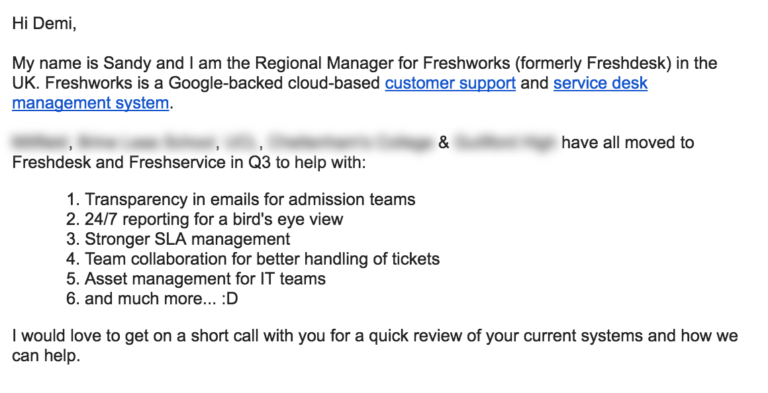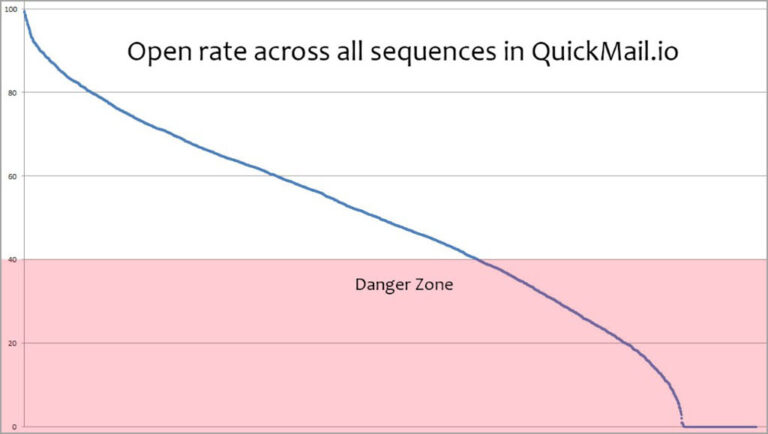14 Scientifically Proven Cold Email Outreach Metrics to Track
Cold email outreach is one of the most effective ways to connect with potential clients. However, not all cold email campaigns are created equal.
What factors do you need to consider to measure the success of your cold email outreach?
To truly gauge the effectiveness of your cold email campaigns and optimize your outreach strategy, you need to focus on the cold email outreach metrics that matter. In this article, we will explore the key performance indicators (KPIs) that can help you boost outreach marketing, and measure the success of your cold email outreach efforts. By understanding and analyzing these metrics, you’ll be equipped with valuable insights to refine your approach, enhance engagement rates, and ultimately drive greater conversions.
So, let’s dive into the world of measurable success in cold email outreach.
What is Cold Email?
Cold email alludes to the act of sending spontaneous messages to people or organizations with whom you have no earlier relationship to start a discussion, fabricate associations, and possibly create leads or deals. It includes connecting with possibilities that have not communicated any express interest in your items or administrations.
Example;

Image Source: Freshworks
The above image is just an example of cold emailing. Let’s move to discuss each of the cold outreach email KPIs to measure the outreach performance.
Cold email outreach automation tools can assist in streamlining and automating the process, allowing for efficient management and scalability of outreach campaigns. These tools help in personalizing and scheduling emails, tracking metrics, managing contacts, and optimizing outreach strategies for better results.
14 Cold Outreach Email KPIs To Watch Out For
Measuring the effectiveness of outreach campaigns is challenging. That’s where Key Performance Indicators (KPIs) or cold email outreach metrics come into play. Below are the 14 cold outreach metrics that we will discuss one by one:
#1. Open Rate
#2. Reply Rate
#3. Engagement Rate
#4. Profile Response Rate
#5. Vertical Rates
#6. Bounce Rate
#7. Overall Click Through Rate (CTR)
#8. Spam Complaint Rate
#9. Unsubscribe Rate
#10. Campaign ROI
#11. Sales revenue
#12. Qualified leads
#13. Follow-up Engagement
#14. Brand Awareness
#1. Open Rate
Open rate refers to the percentage of recipients who open your cold email. It is calculated by dividing the number of emails opened by the total number of emails delivered and multiplying by 100. For example, if you sent 100 emails and 20 were opened, the open rate would be 20%
If you use an email marketing platform like MailChimp, it provides open rate data for your email campaigns. According to a study by MailChimp, the average open rate across industries is around 21.33%.

Image Source: Quickmai.io
A Graph shows that above 60 percent the open rate is a nice benchmark. If you consistently meet the benchmark, you’ll have qualified prospects.
#2. Reply Rate
Reply rate measures the percentage of recipients who respond to your cold email. It is calculated by dividing the number of replies received by the total number of emails delivered and multiplying by 100.
HubSpot analyzed over 25 million emails and found that the average reply rate is approximately 32.8%. For instance, if you received 10 replies from 100 delivered emails, the reply rate would be 10%.
#3. Engagement Rate
The engagement Rate is a crucial metric that measures the level of interaction and interest from recipients in response to cold outreach emails. It is typically calculated by dividing the total number of engagements (such as opens, clicks, and replies) by the total number of delivered emails, and then multiplying by 100 to express it as a percentage. A high engagement rate indicates successful email campaigns and resonating content, while a low rate may suggest the need for improvement in targeting or message effectiveness.
#4. Profile Response Rate
Profile Response Rate measures the percentage of recipients who respond to your cold outreach email based on their alignment with your ideal customer profile. It helps gauge the effectiveness of your targeting efforts and the relevance of your message.
To calculate the profile response rate, divide the number of responses received from your target profiles by the total number of emails sent to those profiles and multiply by 100.
For example, if you sent 250 emails and received 7 responses from your target profiles, your profile response rate would be 17.5%. Tracking this metric allows you to optimize your outreach strategy and focus on engaging with the right audience.
#5. Vertical Rates
Vertical Rates refer to the response rates specific to different industry verticals or target segments. By analyzing the vertical rates, you can identify patterns and trends in engagement within specific industries.
For instance, if you observe higher response rates in the technology sector compared to healthcare, you can adjust your targeting and messaging accordingly. Vertical rates are calculated similarly to profile response rates, by dividing the number of responses within each industry vertical by the total number of emails sent to that vertical and multiplying by 100.
#6. Bounce Rate
Bounce Rate is the percentage of emails that failed to deliver due to various reasons, such as invalid or inactive email addresses. It is essential to monitor bounce rates to maintain a healthy email list and ensure your messages reach the intended recipients. High bounce rates can negatively impact your sender’s reputation and deliverability.
The bounce rate can be calculated by dividing the number of bounced emails by the total number of sent emails and multiplying by 100. The industry benchmark for bounce rates is typically around 2%.
#7. Click Through Rate
Overall Click Through Rate (CTR) measures the percentage of recipients who clicked on links within your cold outreach emails. It indicates the effectiveness of your call-to-action (CTA) and the engagement level of your audience.
To calculate CTR, divide the total number of unique clicks by the total number of delivered emails, and then multiply by 100.
For example, if you had 500 clicks from 10,000 delivered emails, your CTR would be 5%. A higher CTR signifies that your email content is compelling and successfully driving recipients to take action. CTR is one of the top KPIs when it comes to planning the next goal under product marketing strategies.
#8. Spam Complaint Rate
Spam Complaint Rate measures the percentage of recipients who marked your cold outreach emails as spam or unwanted. It is an essential metric to monitor as high spam complaint rates can negatively impact your sender’s reputation and deliverability.
To calculate the spam complaint rate, divide the number of spam complaints received by the total number of delivered emails and multiply by 100. Maintaining a low spam complaint rate is crucial to ensure your emails reach the inbox and maintain a positive sender reputation.
#9. Unsubscribe Rate
Unsubscribe Rate measures the percentage of recipients who opted out or unsubscribed from your cold outreach emails. It indicates the level of interest or dissatisfaction with your email content or overall email marketing strategy.
To calculate the unsubscribe rate, divide the number of unsubscribes by the total number of delivered emails and multiply by 100. For example, if you had 50 unsubscribes from 5,000 delivered emails, your unsubscribe rate would be 1%. It’s important to monitor and manage unsubscribe rates to optimize your email campaigns and ensure you’re providing valuable and relevant content to your audience.
#10. Campaign ROI
Campaign ROI (Return on Investment) measures the profitability of your cold outreach email campaigns. It helps determine the effectiveness of your marketing efforts and the financial returns generated.
To calculate campaign ROI, subtract the total cost of your campaign from the total revenue generated, divide the result by the total cost, and multiply by 100.
For example, if your campaign generated $10,000 in revenue with a total cost of $2,000, your ROI would be 400%. Monitoring campaign ROI allows you to assess the profitability of your email marketing initiatives and make data-driven decisions for future campaigns.
#11 Sales revenue
Sales Revenue refers to the monetary value generated from your cold outreach email campaigns in terms of actual sales made.
It directly measures the impact of your emails on driving revenue for your business. You can track sales revenue by attributing specific sales to the email campaigns that influenced them. This metric helps evaluate the direct impact of your outreach efforts on your bottom line and allows you to assess the overall success and effectiveness of your email marketing strategy.
#12 Qualified Leads
Qualified Leads are prospects who have expressed genuine interest and fit the criteria of your ideal customer profile. This metric measures the number of potential customers that your cold outreach emails have successfully identified and engaged. Tracking qualified leads helps evaluate the quality of your email campaigns in terms of generating valuable opportunities for your sales team. You can determine qualified leads based on specific actions taken by recipients, such as requesting a demo, signing up for a trial, or expressing interest in your product or service.
#13 Follow-up Engagement
Follow-up Engagement measures the level of interaction and response from recipients after initial contact through a cold outreach email. It includes actions such as replies, additional inquiries, or further engagement with your content. Tracking follow-up engagement helps assess the effectiveness of your follow-up strategies and the ongoing interest and potential of your prospects. By nurturing these engagements, you can increase the chances of converting prospects into customers.
#14 Brand Awareness
Brand Awareness measures the extent to which your cold outreach email campaigns contribute to increasing recognition and familiarity with your brand among your target audience. It can be evaluated through surveys, social media mentions, or website traffic generated as a result of your email campaigns. Tracking brand awareness helps assess the effectiveness of your email marketing efforts in building a strong brand presence and increasing the visibility and reputation of your business in the market.
Why Measuring Cold Outreach Emails Is Important?
Measuring cold email outreach efforts is the heart of outreach marketing strategies for every serious business. Businesses small and large use cold email outreach as a pivotal part of their marketing strategy. There are many different reasons why reaching out cold leads to successful results: it’s personal, immediate, and engaging. However, it can be hard to measure the success of your cold email outreach campaign without proper metrics. Luckily, there are many measures that you can take to determine if your campaign is working.
By taking the time to measure the success of your cold email outreach campaign, you can ensure that you are making the most efficient use of your resources. By understanding which metrics matter most, you can optimize your mailed content and messages for maximum impact.
Following these three tips will help ensure a successful outcome for your cold email outreach:
1. Create a clear call to action and Objective
2. Craft an email that speaks directly to your customer’s needs
3. Identify and respond to important objections quickly
Ultimate Inference
Measuring the success of cold email outreach campaigns is vital for optimizing strategies, achieving higher conversions, and building trust. Key performance indicators (KPIs) such as open rate, reply rate, engagement rate, profile response rate, vertical rates, bounce rate, click-through rate (CTR), spam complaint rate, unsubscribe rate, campaign ROI, sales revenue, qualified leads, follow-up engagement, and brand awareness play crucial roles in assessing effectiveness. By tracking these metrics, businesses can refine their approach, improve targeting, and enhance message effectiveness. Clear calls to action, customer-centric emails, and prompt objection handling are essential for successful cold email outreach. Efficient measurement ensures efficient resource utilization and maximizes impact.

